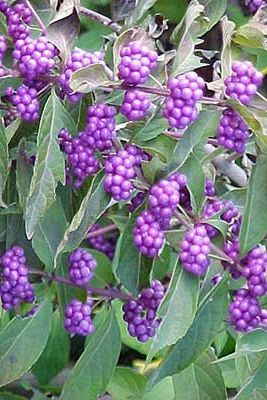Decorative Callicarpa Berries

Callicarpa Beautiful Berries
- The violet-purple beads formed in clusters make these Callicarpa berries look exotic.
- Every branch is strung with these bead like berries through autumn and early winter and lasts for a month once cut for indoor decoration.
- This deciduous shrubs can grow to 10 feet tall and may be lightly tidied up with a bit of trimming or pruning when the buds begin to swell in spring.
- Plant in a sheltered position and avoid any excessive conditions. Put several plants together for good pollination.
- The variety Callicarpa bodinieri ‘Profusion’ is freely available and flowers pink in July and has attractive young and old leaves.
- Callicarpa dichotoma is commonly called the Beauty Berry.
- The seeds are attractive to birds.
Callicarpa Varieties
- Callicarpa bodinieri or Bodinier’s Beautyberry is an ornamental shrub. It is grown in gardens for its decorative purple light-berries.
- Callicarpa dichotoma is also called Purple Beautyberry or Early Amethyst.
- Callicarpa japonica is related to Verbenas
- While the Callicarpa berries are not poisonous to humans they are very bitter. You never see blue fruit (or do you know better?)
Credits
Callicarpa (Beautyberry) at Streissguth Garden in Winter by brewbooks CC BY-SA 2.0


2 thoughts on “Decorative Callicarpa Berries”
Hi,
Please could you possibly help me with a pruning question I have regarding Callicarpa. I currntly have approx 40 bushes of cali, which I pick each May as foliage. I cut the stems so that you can still see the last node – however the bushes have become to be approx 8-10 foot tall. They have many stems comming off each branch which seems to be stunting the actual stem lenght – the stems themselves are geeting shorter. Please could you give me advise on how best to prune them.
Many thanks in advance.
Michelle Rogers – 0438 192021
20 Karinga Road
Monbulk Vic
I would give them plenty of feed and a mulch if you are cropping them every year.
Also try reducing the height of one or two and see how they perform they may have grown too tall.
Comments are closed.